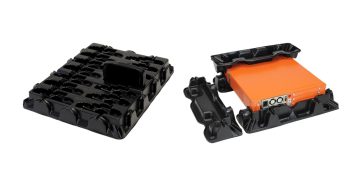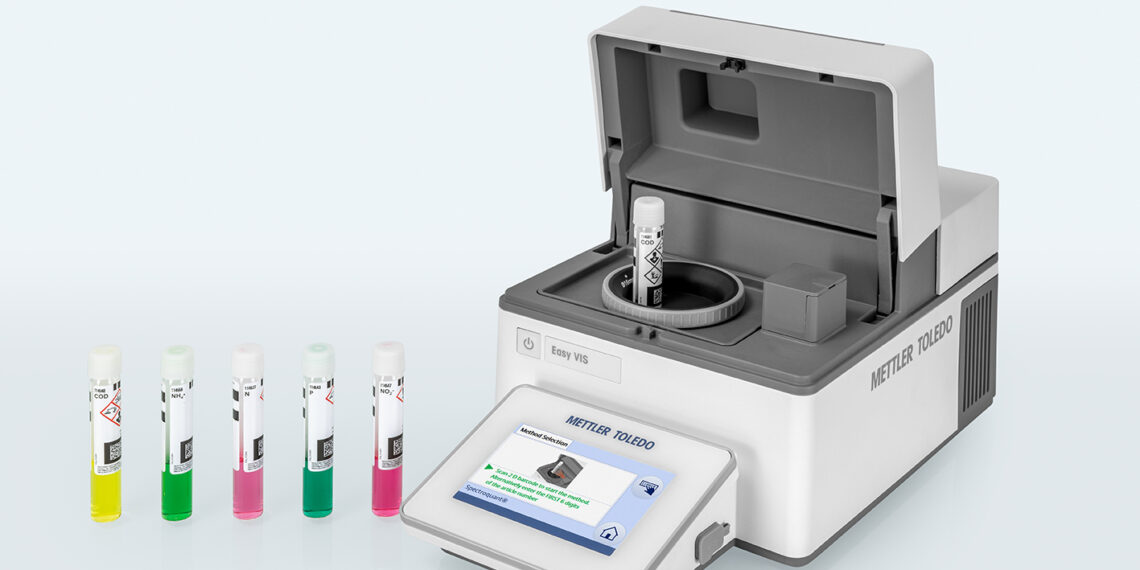The new instrument analyzes liquid, translucent samples for their optical spectrum, color, and water parameters. Or any of the three. Operators speed up their processes and improve the quality of the results using Easy VIS. They, therefore, save money, time, and space.
 The compact Easy VIS by Mettler Toledo efficiently analyzes fluid and translucent samples. As a true all-rounder, it covers three measuring tasks in one instrument.
The compact Easy VIS by Mettler Toledo efficiently analyzes fluid and translucent samples. As a true all-rounder, it covers three measuring tasks in one instrument.
The instrument takes over the measuring tasks of up to three instruments: a colorimeter, a spectrophotometer, and special measuring methods for water testing, such as titration. All this power rests in one instrument about the size of a notebook. The results appear on screen in trustworthy accuracy, precision, and repeatability – within seconds. That saves money, time, and space. The instrument’s name is Easy VIS, one of the next-generation EasyPlus UV/VIS spectrophotometers produced by Mettler Toledo.
Ease of use in a new dimension: Closing the lid of the Easy VIS spectrophotometer produced by Mettler Toledo automatically starts the measurement.
Manufacturers benefit in many ways
A typical place for Easy VIS is the QC lab at small manufacturers in the food and beverage industry, environmental testing labs, or any industry needing quality control and supervising their process- or wastewaters. The Easy VIS is used during multiple steps of the production process: For inspection of raw materials, quality control of semi-finished and finished products, or testing the water quality of wastewater.
This streamlines the production processes considerably. Those who used to send their samples to an external laboratory profit even more, as they can now analyze most samples independently at an internal cost.
The visual user interface with workflow guidance allows you to simply scan and measure. Even untrained staff can operate Easy VIS intuitively. This increases the integrity and repeatability of the analysis and saves training time.
Easy VIS operates within a wavelength range of 330 to 1,000 nm. The light source is an easy-to-replace tungsten lamp, which any operator can replace within no time.
The partner device, Easy UV, covers the full UV/Vis spectrum with a wavelength range from 190 to 1,000 nm to cover additional applications in the UV range. Plus: The Easy UV runs with a power-saving and maintenance-free xenon-flash lamp.
Analytic precision in three fields of expertise
25 standard-compliant color scales in the visible range come pre-installed and can easily be used. Some examples are ICUMSA for sugar color, ESBC for beer quality analysis, or OIV CIELab for wine color determination. The results reveal the quality of the product within seconds.
Water analysis shows, for example, the concentration of Aluminum, Ozone, Chlorine, or Polyphenol. This reveals whether the water is fit for human consumption or can be used in further production. Is the wastewater safe to release? With its numerous built-in water testing methods, the spectrophotometer can quickly provide the answer.
For spectrophotometry, the sample is analyzed at the wavelengths where the sample has its characteristic absorption of light. The Easy VIS measures the transmitted or absorbed light and the reading reveals the sample’s concentration or purity.
The PathDetect function of the compact Easy VIS spectrophotometer produced by Mettler Toledo recognizes which path length is measured and reduces errors.
A typical analysis with the Easy VIS
The testing procedure is very simple: One cuvette holds the blank measurement, and another is prepared with the sample. After choosing the desired analysis method, the cuvette is placed in the cuvette holder. The PathDetect function recognizes which path length is measured. Closing the lid automatically starts the blank measurement. (By the way, the blank measurement is stored for seven days. So, this step can be neglected during the rest of the week unless the measurement parameters change). After determining the blank, the sample cuvette is brought into the measuring position. The measurement starts again automatically after closing the lid. Within seconds, the results show up on the screen. Now Easy VIS is free to analyze other samples or to start a different analysis method. With the EasyDirect software, these results may be automatically saved or exported to an external storage device or exchanged with a data management system (for example LIMS).
Conclusion
 Easy VIS has the potential to replace up to three other instruments, performing color measurement, water analysis, and spectrophotometry. It does so with trusted accuracy and precision – within several steps of the production process. All this saves money, time, and space. Check with your local Mettler Toledo representative about how unique the price performance is!
Easy VIS has the potential to replace up to three other instruments, performing color measurement, water analysis, and spectrophotometry. It does so with trusted accuracy and precision – within several steps of the production process. All this saves money, time, and space. Check with your local Mettler Toledo representative about how unique the price performance is!
Good to know
Mettler Toledo’s new EasyPlus instrument line embraces the Easy VIS and Easy UV spectrophotometer. Both instruments offer equal benefits to their operators in accuracy, speed, and compactness. They differ in two aspects: wavelength range and light source. The Easy UV is of special interest to those working within the UV range from 190 to 1,000 nm. Its xenon-flash lamp is maintenance-free and requires no changing.

















